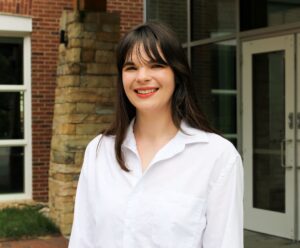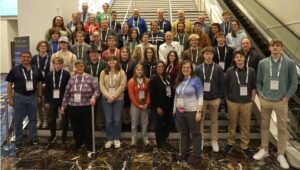By Steve Esser
YOUNG HARRIS, Ga. — Lauren Albin, planetarium director at Young Harris College, has been selected as part of a national research project in astronomy. She was one of the first instructors in Georgia to be named to the project. NITARP, the NASA/IPAC Teacher Archive Research Program, brings teachers together from across the nation for astronomical research.
astronomy. She was one of the first instructors in Georgia to be named to the project. NITARP, the NASA/IPAC Teacher Archive Research Program, brings teachers together from across the nation for astronomical research.
Albin was picked for the 2025 team working with Dr. Varoujan Gorjian, with three other educators: Ben Senson, educator mentor, Madison Metropolitan School District Planetarium and Madison College, Madison, WI; Meredith Cullen, UMS-Wright Preparatory School, Mobile, AL, and; Kevin Molohon, Champlin Park High School, Champlin, MN. Gorjian Gorijan is a scientist working at NASA’s Jet Propulsion Laboratory and is a part of NASA’s SphereX mission, which is scheduled to launch in late February.
“This is a great honor to get to work with other professionals in the astronomy field,” Albin said. “The purpose of this program is to provide educators with an authentic research experience in astronomy using data housed at NASA’s Infrared Processing and Analysis Center (IPAC) at the California Institute of Technology in Pasadena.”
NITARP partners small groups of educators with a mentor professional astronomer for a year-long original research project using NASA’s archives of astronomical data from space- and ground-based telescopes. Including this 2025 class, NITARP has worked with 152 educators from 44 states, and the 2025 class includes the first participants from Georgia and Alabama.
In exchange, the program asks the educators to leverage this experience by providing professional development for colleagues in their local school districts. Albin plans to select two high school students from the surrounding area to work on the research team alongside her.
They potentially will be able to join the research team in Los Angeles to tour Caltech & JPL, as well as attend the 2026 American Astronomical Society Winter meeting in Phoenix. It involves several trips for educator participants and their students to collaborate with scientists and present the research results, all of which are paid for by the program.
The program runs January through January, with each team writing up the results of their research and presenting it in a science poster session at an American Astronomical Society meeting (AAS is the professional organization for astronomers in the U.S.). The instructors are also encouraged to involve students at their school in the research.
 “We just met our team at the last meeting and are learning about our projects,” Albin said. “We will present our results, with our students, at the 2026 AAS winter meeting in Phoenix, AZ.”
“We just met our team at the last meeting and are learning about our projects,” Albin said. “We will present our results, with our students, at the 2026 AAS winter meeting in Phoenix, AZ.”
IPAC, based at Caltech, in Pasadena, CA, leads this program. These teams will use archival data from the NASA/IPAC Infrared Science Archive (IRSA), the NASA/IPAC Extragalactic Database (NED), and the NASA Exoplanet Archive, all of which are based at IPAC, while also supplementing these data from other NASA archive holdings. Funding comes from the NASA Astrophysics Data Analysis Program.
About Young Harris College
Young Harris College is a private baccalaureate and master’s degree-granting institution located in the beautiful mountains of North Georgia. Founded in 1886 and historically affiliated with The United Methodist Church, Young Harris College educates, inspires, and empowers students through an education that purposefully integrates the liberal arts and professional studies. The College has four academic divisions: Fine Arts; Humanities; Mathematics, Science, and Technology; and Professional Studies. Approximately 1,400 students are enrolled in its residential and Early College programs. The College is an active member of the NCAA Division II and remains a fierce competitor in the Conference Carolinas. For more information, visit yhc.edu.

